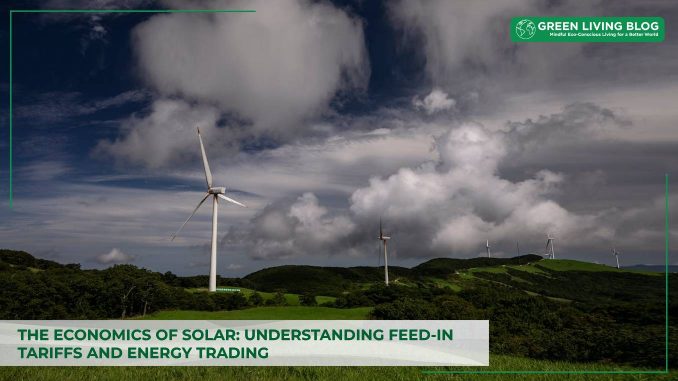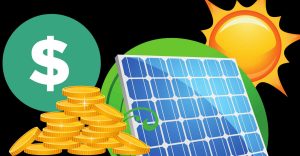
As a pivotal policy mechanism designed to boost investment in renewable energy, Feed-in Tariffs aka FITs have played a crucial role in the solar sector’s growth.
We’ll explore the fundamentals of FITs, their benefits, the challenges they face, and how they fit into the broader solar energy market dynamics.
From the potential future directions of solar economics to real-world case studies, join us on this enlightening journey to understand how FITs are shaping the solar energy landscape and what this means for the planet’s sustainable future.
Fundamentals of Feed-in Tariffs (FITs) for Solar Energy
Feed-in Tariffs (FITs) are policies designed to accelerate investment in renewable energy technologies by offering long-term contracts to renewable energy producers, typically based on the cost of generation of each technology.
For solar energy, FITs guarantee a fixed, premium payment for the electricity generated, encouraging the adoption and investment in solar installations.
Definition and Mechanism of Feed-in Tariffs

Feed-in Tariffs (FITs) are a policy mechanism designed to accelerate investment in renewable energy technologies by providing long-term contracts to renewable energy producers, typically based on the cost of generation of each technology. Feed-in Tariffs ensure that energy producers are paid a set price for the power they generate and feed into the grid, making renewable energy ventures more financially viable.
The mechanism works as follows:
- A government or regulatory body sets a fixed, guaranteed price for renewable energy.
- Renewable energy producers, such as solar panel owners, sign up for the FIT program.
- The energy produced is fed into the national grid.
- The producer is paid the agreed FIT rate for each unit of electricity generated.
This system is designed to offer stability and predictability, which are crucial for investors and producers when planning and financing solar projects. By ensuring a specific return on investment, FITs can help overcome the initial cost barriers associated with solar installations. Moreover, they contribute to the growth of the solar community by making renewable energy more accessible and financially attractive. You can check out The Solar Upgrade for good economic options.
The Evolution of FIT Policies Worldwide
Feed-in Tariff (FIT) policies have undergone significant changes since their inception. Initially designed to support the nascent solar industry, FITs have evolved to address the growing complexities of the energy market. Governments worldwide have adapted FITs to reflect technological advancements and market conditions, ensuring that these policies remain effective in promoting renewable energy.
Key developments in the evolution of FIT policies include:
- The introduction of degression rates, which gradually reduce the tariff paid to solar producers over time, encourages cost reductions and technological efficiency.
- The shift towards performance-based incentives, where payments are tied to the actual electricity produced, rather than the capacity installed.
- The adoption of market integration mechanisms, such as competitive bidding and auctions, to better align FITs with market prices and avoid overcompensation.
These changes reflect a broader trend towards more dynamic and market-responsive solar energy policies, which aim to balance the encouragement of solar power with the need for financial sustainability and market integration.
Analyzing the Benefits of Feed-in Tariffs
Feed-in Tariffs have several benefits, including stimulating the renewable energy sector, reducing greenhouse gas emissions, and promoting energy independence. By providing a reliable income stream, FITs make solar energy projects more financially viable and attractive to investors, leading to increased solar capacity and technological advancements.
Incentivizing Solar Power Generation
 Feed-in Tariffs (FITs) serve as a powerful incentive for homeowners, businesses, and utilities to invest in solar power generation. By guaranteeing a fixed, attractive price for the electricity produced, FITs reduce the financial risk associated with solar investments and help to create a stable market environment.
Feed-in Tariffs (FITs) serve as a powerful incentive for homeowners, businesses, and utilities to invest in solar power generation. By guaranteeing a fixed, attractive price for the electricity produced, FITs reduce the financial risk associated with solar investments and help to create a stable market environment.
The economic attractiveness of FITs often leads to a rapid increase in solar capacity installations. This growth is further supported by the declining costs of solar technology, such as the SunGold Power 5000W 48V Solar Charger Inverter, which offers a robust solution for both grid-tied and off-grid systems.
Key benefits of FITs include:
- Long-term contracts that provide income certainty
- Access to finance due to reduced investment risk
- Accelerated return on investment, making solar projects more appealing
However, the success of FITs in incentivizing solar power generation depends on careful policy design to balance market stimulation with financial sustainability.
Economic and Environmental Impacts
Feed-in Tariffs (FITs) have a profound impact on both the economy and the environment. By guaranteeing a fixed, premium price for solar-generated electricity, FITs make investing in solar technology more attractive to homeowners and businesses alike. This financial incentive has led to a surge in solar installations, contributing to job creation in the renewable energy sector.
The environmental benefits are equally significant. As more solar power is integrated into the energy mix, the reliance on fossil fuels diminishes, leading to a reduction in greenhouse gas emissions. This shift helps combat climate change and reduces air pollution, improving public health. Moreover, the decentralized nature of solar power generation can enhance energy security and reduce the need for expensive, centralized infrastructure.
- Job creation in the renewable energy sector
- Reduction in greenhouse gas emissions
- Improved public health due to cleaner air
- Enhanced energy security
Challenges and Criticisms of Feed-in Tariffs
Despite their benefits, FITs face criticism for potentially high costs passed onto consumers, market distortion, and over-reliance on government subsidies. Critics argue that FITs might encourage inefficient solar installations or become financially unsustainable if not carefully managed.
Financial Sustainability and Market Integration
The financial sustainability of Feed-in Tariffs (FITs) is a pressing concern for policymakers and investors alike. As solar energy becomes more widespread, the costs associated with FITs can escalate, potentially burdening taxpayers and electricity consumers with higher rates.
Market integration challenges arise when solar power, incentivized by FITs, must compete with traditional energy sources. This competition can lead to market distortions and necessitate careful regulatory adjustments to maintain a level playing field.
- Ensuring the long-term viability of FITs requires balancing generous incentives with fiscal responsibility.
- Adapting tariff rates to reflect the declining cost of solar technology is crucial for sustainable growth.
- Integrating solar energy into the broader market demands innovative approaches to grid management and energy storage solutions.
Transitioning Away from Feed-in Tariffs
As the solar energy market matures, many regions are transitioning away from feed-in tariffs (FITs). This shift is driven by the need to integrate solar power more effectively into the energy market and to address the financial challenges associated with FITs. The transition involves several key steps:
- Evaluating the current impact of FITs on the energy market and identifying areas for improvement.
- Developing alternative support mechanisms that can provide more market-oriented incentives for solar energy investment.
- Implementing gradual reductions in FIT rates to minimize market disruption and allow for a smoother adjustment period for solar investors and producers.
During this transition, it is crucial to maintain a balance between encouraging solar energy adoption and ensuring the financial sustainability of the energy sector. New policies and support mechanisms are being explored to replace FITs, such as competitive auctions, tax incentives, and direct subsidies. These alternatives aim to promote solar energy while fostering a more dynamic and resilient energy market.
Solar Energy Trading and Market Dynamics
Solar energy trading involves the buying and selling of solar-generated electricity through markets or bilateral agreements. Market dynamics are influenced by supply and demand, technological advancements, policy changes, and economic factors. Effective trading mechanisms can enhance the integration of solar energy into the grid and promote its economic viability.
The Role of Energy Trading in Solar Economics
 In the context of the ‘Economics of Solar: Understanding Feed-in Tariffs and Energy Trading’, the significance of Energy Trading cannot be overstated. It serves as a pivotal mechanism for integrating solar power into the energy market, allowing for the efficient distribution and utilization of solar-generated electricity.
In the context of the ‘Economics of Solar: Understanding Feed-in Tariffs and Energy Trading’, the significance of Energy Trading cannot be overstated. It serves as a pivotal mechanism for integrating solar power into the energy market, allowing for the efficient distribution and utilization of solar-generated electricity.
Energy Trading is essential for balancing supply and demand in real time, providing a platform for solar producers to sell excess energy. This not only ensures that solar energy is effectively integrated into the grid but also helps in stabilizing electricity prices.
The Economics of solar is greatly influenced by the dynamics of Energy Trading. Here are some key points to consider:
- The ability to trade solar energy encourages market competitiveness.
- It creates revenue streams for solar power producers, enhancing the attractiveness of solar investments.
- Energy Trading platforms can facilitate peer-to-peer transactions, fostering community-based energy initiatives.
Emerging Models and Technologies in Solar Energy Trading
The landscape of solar energy trading is rapidly evolving with the introduction of new models and technologies. Blockchain technology, for instance, has emerged as a pivotal tool for ensuring transparency and security in energy transactions. This innovation allows for the creation of decentralized platforms where producers and consumers can trade energy without the need for traditional intermediaries.
Key developments in this area include:
- Peer-to-peer (P2P) energy trading platforms that empower individuals to buy and sell solar power directly among themselves.
- The use of smart contracts to automate the execution of energy trades, reducing the need for manual intervention and increasing efficiency.
- Integration of artificial intelligence to optimize energy distribution and pricing strategies, catering to the dynamic nature of solar power generation.
These advancements are not only enhancing the efficiency of solar energy markets but are also paving the way for more inclusive and democratized energy systems. Companies like The Solar Upgrade are at the forefront of this transformation, offering solar products with comprehensive policies and support to facilitate participation in these emerging markets.
Future Directions in Solar Energy Economics
The economics of solar energy are evolving, with trends pointing towards decreased reliance on subsidies like FITs and increased market competitiveness. Innovations in storage technology, grid integration, and decentralized energy systems are expected to further reduce costs and improve the efficiency and reliability of solar energy.
Beyond FITs: New Incentives for Solar Investment
As the solar industry matures, governments and private entities are exploring new incentives to encourage solar investment beyond traditional Feed-in Tariffs (FITs). Innovative financing models and subsidies are emerging to reduce the initial cost barrier and promote widespread adoption of solar technology.
- Green bonds and solar renewable energy certificates (SRECs) offer alternative ways for investors to support solar projects while potentially earning a return.
- Tax credits and rebates continue to play a significant role, providing direct financial benefits to solar adopters.
- Performance-based incentives (PBIs) reward the actual energy production, aligning interests with efficiency and long-term operation.
Partnerships between solar companies and financial institutions are also crucial. They facilitate access to loans and leasing options, making solar installations more accessible to a broader audience. Moreover, the integration of solar products, such as batteries, inverters, cables, and accessories, into energy solutions is supported by comprehensive policies and customer support, ensuring a smoother transition for new adopters.
The Role of Technological Advancements and Solar Efficiency
Technological advancements in the solar industry have been pivotal in driving down costs and improving the efficiency of solar panels. Boldly pushing the boundaries of photovoltaic (PV) technology, researchers and manufacturers have achieved significant milestones in solar cell efficiency, making solar power more competitive with traditional energy sources.
Key developments include the use of new materials and the refinement of manufacturing processes. For instance, the introduction of perovskite solar cells offers the potential for higher efficiency rates at lower production costs. Additionally, smart solar panels equipped with sensors and software can optimize their position to maximize sunlight exposure throughout the day.
The economic landscape of solar energy is also shaped by the efficiency of solar products and their pricing. Companies like SolarUpgrade are instrumental in providing cost-effective solutions, with pricing per KWh that makes solar adoption more accessible to a wider range of consumers. As the market continues to evolve, the interplay between technological innovation and economic incentives will be crucial in determining the trajectory of solar energy adoption.
Case Studies: Success Stories and Lessons Learned
Success stories from countries that have effectively implemented FITs, such as Germany and Japan, showcase the potential for rapid solar energy expansion and innovation.
These case studies reveal important lessons in policy design, including the need for flexibility, caps, and gradual reductions in tariff rates to ensure sustainability and continued growth in the solar sector.
Global Examples of Effective FIT Programs

Around the world, several countries have successfully implemented Feed-in Tariff (FIT) programs, leading to significant growth in their solar energy sectors. Germany stands out as a pioneer, with its Energiewende policy which has been instrumental in boosting solar installations. The German FIT scheme offered long-term contracts and attractive payment rates for solar energy producers, which resulted in a solar power boom.
In Japan, the introduction of a generous FIT program post-Fukushima disaster led to a rapid expansion of solar capacity. The Japanese government set high purchase prices for solar-generated electricity, encouraging a wave of investments in solar technology.
Similarly, in Spain, the early adoption of FITs spurred the development of one of the world’s largest solar power plants, although adjustments to the policy later on led to market challenges.
Other notable examples include Ontario, Canada, where the Green Energy Act implemented a FIT program that not only increased solar power generation but also promoted local job creation and economic growth. The program’s success was partly due to its emphasis on community and aboriginal participation. These case studies demonstrate the potential of FITs to transform a nation’s energy landscape when thoughtfully designed and consistently supported.
Transition Stories: Adapting to New Solar Incentives
As the solar industry evolves, so too do the incentive structures that support its growth. Countries around the world are transitioning away from traditional feed-in tariffs to more dynamic models that reflect the changing energy landscape. This shift often involves a complex interplay of policy adjustments, market readiness, and technological innovation.
- In Germany, the move towards self-consumption models has been facilitated by the gradual reduction of FIT rates. This encourages solar system owners to use more of the energy they produce, rather than exporting it to the grid.
- Japan has seen a similar trend, with a focus on creating a balanced market mechanism that promotes both energy self-sufficiency and grid stability.
These transitions are not without their challenges, as they require existing solar producers to adapt to new market realities. However, the lessons learned from these adaptations are invaluable for informing future policy and ensuring the sustainable growth of solar energy.
Conclusion
FITs have been instrumental in propelling the solar industry forward, offering a stable and attractive financial incentive for the adoption of solar power. However, as the solar market matures, the challenges of financial sustainability and market integration have prompted a reevaluation of these policies. Energy trading has emerged as a dynamic component of solar economics, with new models and technologies fostering a more flexible and efficient energy landscape.
The future of solar economics is poised for transformation, with technological advancements and shifts in incentive structures shaping a more resilient and adaptable solar industry. By examining global case studies, we gain valuable insights into the successes and lessons learned, providing a roadmap for future policies and investments. As we continue to strive for a sustainable energy future, the evolution of solar economics remains a critical area of focus, balancing the need for innovation with the imperatives of economic viability and environmental stewardship.
![]()
Author Profile
- Online Media & PR Strategist
- Blogger and Educator by Passion | Senior Online Media & PR Strategist at ClickDo Ltd. | Fascinated to Write Lifestyle Blogs in News & Education I have completed a journalism summer course at the London School of Journalism and manage various blogs.
Latest entries
 EnvironmentApril 22, 2024The Potential for Geothermal Energy in the UK Heats Up
EnvironmentApril 22, 2024The Potential for Geothermal Energy in the UK Heats Up TechnologyApril 20, 2024Do You Want to Become a Sustainable Investor? A Beginner’s Guide to Sustainable Investing
TechnologyApril 20, 2024Do You Want to Become a Sustainable Investor? A Beginner’s Guide to Sustainable Investing Green Expert GuidesApril 5, 2024The Economics of Solar: Understanding Feed-in Tariffs and Energy Trading
Green Expert GuidesApril 5, 2024The Economics of Solar: Understanding Feed-in Tariffs and Energy Trading BusinessMarch 26, 2024What are the Sustainable Benefits of Selling Surplus?
BusinessMarch 26, 2024What are the Sustainable Benefits of Selling Surplus?






Leave a Reply
You must be logged in to post a comment.